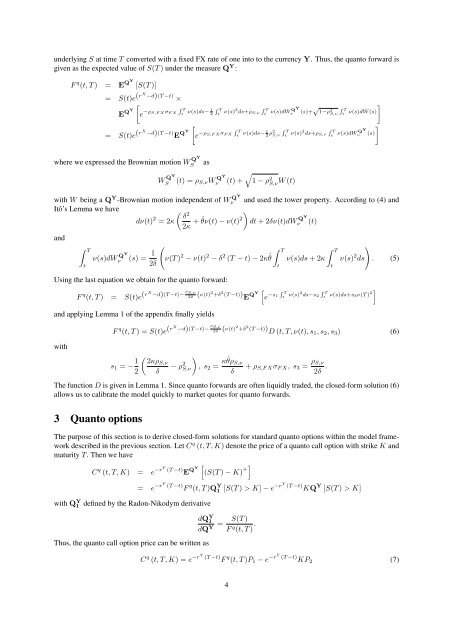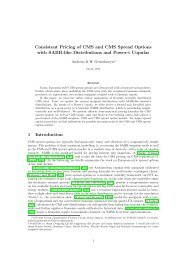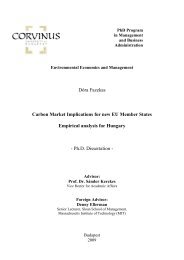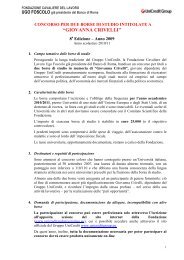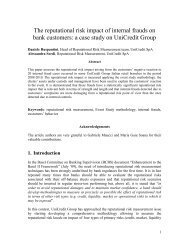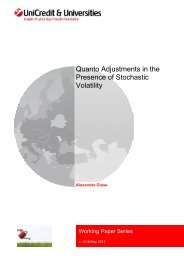Quanto Adjustments in the Presence of Stochastic Volatility
Quanto Adjustments in the Presence of Stochastic Volatility
Quanto Adjustments in the Presence of Stochastic Volatility
Create successful ePaper yourself
Turn your PDF publications into a flip-book with our unique Google optimized e-Paper software.
underly<strong>in</strong>g S at time T converted with a fixed FX rate <strong>of</strong> one <strong>in</strong>to to <strong>the</strong> currency Y. Thus, <strong>the</strong> quanto forward is<br />
given as <strong>the</strong> expected value <strong>of</strong> S(T ) under <strong>the</strong> measure Q Y :<br />
F q (t, T ) = E QY<br />
[S(T )]<br />
= S(t)e (rX −d)(T −t) ×<br />
E QY<br />
�<br />
e −ρS,F<br />
� T<br />
�<br />
1 T<br />
X σF X ν(s)ds− t 2 t ν(s)2 � T<br />
ds+ρS,ν t<br />
= S(t)e (rX −d)(T −t) E Q Y<br />
QY<br />
ν(s)dWν (s)+ √ 1−ρ2 �<br />
� T<br />
S,ν ν(s)dW (s)<br />
t<br />
�<br />
e −ρS,F<br />
� T<br />
1<br />
X σF X ν(s)ds− t 2 ρ2<br />
� T<br />
S,ν t ν(s)2 � T<br />
ds+ρS,ν t<br />
where we expressed <strong>the</strong> Brownian motion W QY<br />
S as<br />
W QY<br />
S (t) = ρS,νW QY<br />
�<br />
ν (t) + 1 − ρ2 S,νW (t)<br />
�<br />
QY<br />
ν(s)dWν (s)<br />
with W be<strong>in</strong>g a QY-Brownian motion <strong>in</strong>dependent <strong>of</strong> W QY<br />
ν and used <strong>the</strong> tower property. Accord<strong>in</strong>g to (4) and<br />
Itô’s Lemma we have<br />
dν(t) 2 � 2 δ<br />
= 2κ<br />
2κ + ˆ θν(t) − ν(t) 2<br />
�<br />
dt + 2δν(t)dW QY<br />
ν (t)<br />
and<br />
� T<br />
t<br />
ν(s)dW QY<br />
ν (s) = 1<br />
�<br />
ν(T )<br />
2δ<br />
2 − ν(t) 2 − δ 2 (T − t) − 2κˆ � T<br />
� T<br />
θ ν(s)ds + 2κ ν(s)<br />
t<br />
t<br />
2 �<br />
ds . (5)<br />
Us<strong>in</strong>g <strong>the</strong> last equation we obta<strong>in</strong> for <strong>the</strong> quanto forward:<br />
F q (t, T ) = S(t)e (rX −d)(T −t)− ρS,ν 2δ (ν(t) 2 +δ 2 � Y<br />
(T −t)) Q<br />
E e −s1<br />
� T<br />
t ν(s)2 � T<br />
ds−s2 ν(s)ds+s3ν(T )2�<br />
t<br />
and apply<strong>in</strong>g Lemma 1 <strong>of</strong> <strong>the</strong> appendix f<strong>in</strong>ally yields<br />
with<br />
F q (t, T ) = S(t)e (rX −d)(T −t)− ρ S,ν<br />
2δ (ν(t) 2 +δ 2 (T −t)) D (t, T, ν(t), s1, s2, s3) (6)<br />
s1 = − 1<br />
�<br />
2κρS,ν<br />
2 δ<br />
− ρ2 �<br />
S,ν , s2 = κˆ θρS,ν<br />
δ<br />
+ ρS,F XσF X, s3 = ρS,ν<br />
2δ .<br />
The function D is given <strong>in</strong> Lemma 1. S<strong>in</strong>ce quanto forwards are <strong>of</strong>ten liquidly traded, <strong>the</strong> closed-form solution (6)<br />
allows us to calibrate <strong>the</strong> model quickly to market quotes for quanto forwards.<br />
3 <strong>Quanto</strong> options<br />
The purpose <strong>of</strong> this section is to derive closed-form solutions for standard quanto options with<strong>in</strong> <strong>the</strong> model framework<br />
described <strong>in</strong> <strong>the</strong> previous section. Let C q (t, T, K) denote <strong>the</strong> price <strong>of</strong> a quanto call option with strike K and<br />
maturity T. Then we have<br />
C q (t, T, K) = e −rY � Y<br />
(T −t) Q<br />
E (S(T ) − K) +�<br />
with Q Y 1 def<strong>in</strong>ed by <strong>the</strong> Radon-Nikodym derivative<br />
Thus, <strong>the</strong> quanto call option price can be written as<br />
= e −rY (T −t) F q (t, T )Q Y 1 [S(T ) > K] − e −rY (T −t) KQ Y [S(T ) > K]<br />
dQY 1 S(T )<br />
=<br />
dQY F q (t, T ) .<br />
C q (t, T, K) = e −rY (T −t) F q (t, T )P1 − e −rY (T −t) KP2<br />
4<br />
(7)


